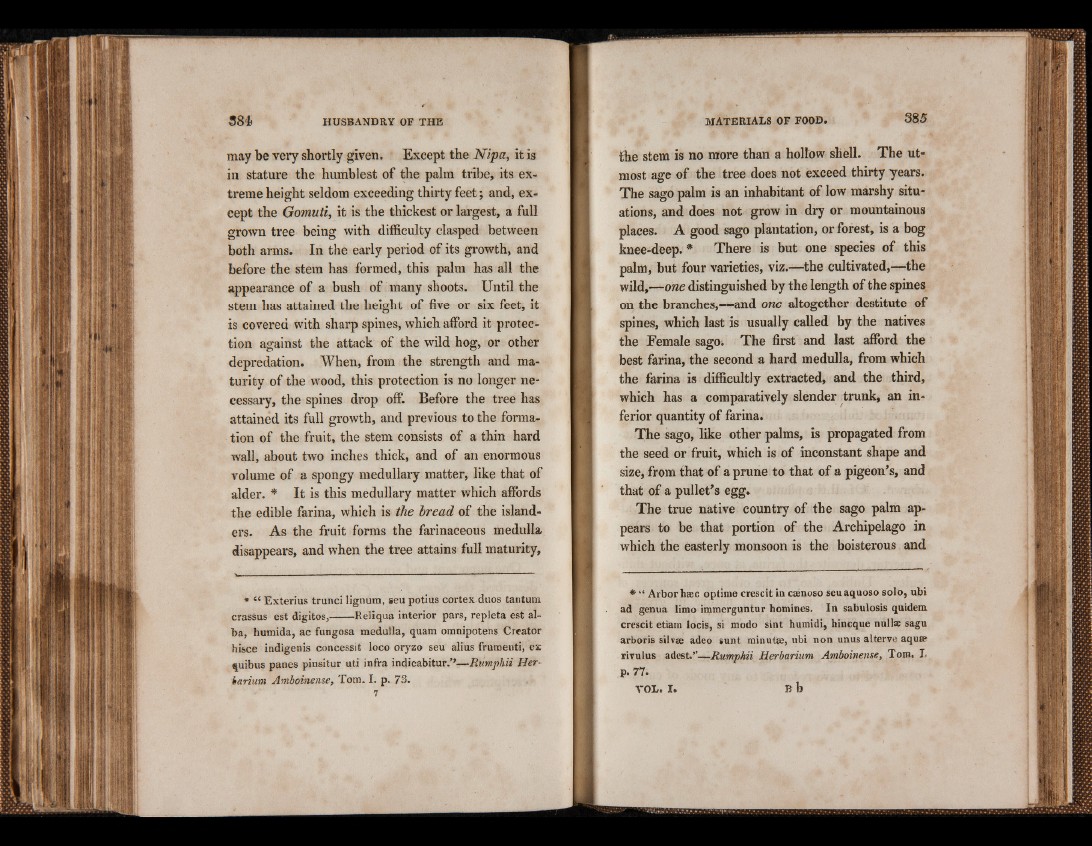
may be very shortly given. Except the Nipa, it is
in stature the humblest of the palm tribe, its extreme
height seldom exceeding thirty feet; and, except
the Gomuti, it is the thickest or largest, a full
grown tree being with difficulty clasped between
both arms. In the early period of its growth, and
before the stem has formed, this palm has all the
appearance of a bush of many shoots. Until the
stem has attained the height of five or six feet, it
is covered with sharp spines, which afford it protection
against the attack of the wild hog, or other
depredation. When, from the strength and maturity
of the wood, this protection is no longer necessary,
the spines drop off. Before the tree has
attained its full growth, and previous to the formation
of the fruit, the stem consists of a thin hard
wall, about two inches thick, and of an enormous
volume of a spongy medullary matter, like that of
alder. * I t is this medullary matter which affords
the edible farina, which is the bread of the islanders.
As the fruit forms the farinaceous medulla
disappears, and when the tree attains full maturity,
* <{ Exterius trunci lignum, seu potius cortex duos tantum
crassus est digitos, Reliqua interior pars, repleta est alba,
humida, ac fungosa medulla, quam omnipotens Creator
hisce indigenis concessit loco oryzo seu alius frumenti, ex
quibus panes pinsitur uti infra indicabitur.’’— Rimphii Herbarium
Amboinense, Tom. I. p. 73.
7
the stem is no more than a hollow shell. The utmost
age of the tree does not exceed thirty years.
The sago palm is an inhabitant of low marshy situations,
and does not grow in dry or mountainous
places. A good sago plantation, or forest, is a bog
knee-deep.* There is but one species of this
palm, but four varieties, viz.—the cultivated,—the
wild,—one distinguished by the length of the spines
on the branches,—and one altogether destitute of
spines, which last is usually called by the natives
the Female sago; The first and last afford the
best farina, the second a hard medulla, from which
the farina is difficultly extracted, and the third,
which has a comparatively slender trunk, an inferior
quantity of farina.
The sago, like other palms, is propagated from
the seed or fruit, which is of inconstant shape and
size, from that of a prune to that of a pigeon’s, and
that of a pullet’s eggs,
The true native country of the sago palm appears
to be that portion of the Archipelago in
which the easterly monsoon is the boisterous and
* “ Arbor haec optime crescit in caenoso seuaquoso solo, ubi
ad genua limo immerguntur homines. In sabiilosis quidem
crescit etiam locis, si modo sint humidi, hincque null® sagu
arboris silvae adeo sunt minutse, ubi non unus alterve aquae
rivulus adest.”— Rumphii Herbarium Amboinense, Tom. L
p. 77.